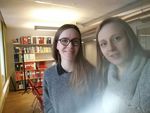Report by Anastasia Shakhaeva, 2018 - Women in Tech - Swedish Best Practices in Promoting Equality and Empowering Women in Tech and Digital
←
→
Page content transcription
If your browser does not render page correctly, please read the page content below
Report by Anastasia Shakhaeva, 2018
Women in Tech – Swedish Best Practices in Promoting Equality and
Empowering Women in Tech and Digital
I came to Sweden to study practicalities –
how Swedish tech companies address
issues of gender inequality at work and
what policies they have – but came back
not only with that but also with a better
understanding of structural societal
inequalities that are at work in the tech
world.
I have been working in tech and digital
since I graduated, and at some point I’ve
begun to realize how women are seen and
mistreated at the workplaces and how
they suffer from internal misogyny. I was
one of these women and I started a long
way to fighting sexism with my own
example, wherever I worked.
Knowing that Sweden is one of the top
gender equal countries in the world, and
Stockholm – the biggest tech startup city
of Europe, it was only natural that I would
decide to research the way things are
done in Sweden in order to try and transfer some of that knowledge to my current company and the product
management community I am part of.
My research consisted mainly of interviews with the industry leaders representing either companies, academia
or not-for-profit organizations aimed at helping women become a part of the tech industry and develop as
professionals.
Among others I got to meet Anna Sitnikova from iZettle, Charlotta Bodin from Volvo (and Eriksson), Hanna
Söderquist from Netlight, Karin Callin — the woman behind the Skill Capture program in Scania, Linnea
Jonjons from Metro, Szilvia Varszegi from Klarna and Yanina Komarova from Truecaller. I collected a long list
of pro-gender-equality steps one can do in their company, like: antidiscrimination trainings for new employees,
mentorship and networking programs for women inside the organization, additional payments during parental
leave (so that the overall payments would amount to the regular salary), regular HR trainings to raise
awareness about gender bias, professional workshops, making the gender balance one of the company’s
quantitative objectives, rewriting the job posts from female perspective, asking the recruiters to work on
recruiting only women one day a week and creating full blown programs like Scania’s Skill Capture, aimed at
diversifying the company in all aspects, not only the gender aspect.I was also wondering what kind of work do not-for-profit organizations dealing with women in tech. I managed to get a hold on Datatjej and met with Moa Marklund in Uppsala — the organization is run by students and aimed at helping female students advance in their studies in the tech field and connect them with possible mentors and employers. Another organization taking care of women leaders in the tech industry is Female Leader Engineer. It is aimed at finding women leaders in engineering, train them and connect them to 8 biggest partner tech companies and then make them part of the alumni network of the program. Lisa Guldstrand wasn’t just a nice person to interview but we actually connected and became friends. I was also lucky to meet Tina Sayed Nestius from Rättviseförmedlingen. Rättviseförmedlingen is an amazing company that on the one hand makes female professionals visible and helps companies diversify speaker and panel gender composition, and on the other hand raises awareness around how much women and other discriminated groups are represented in the media. They developed their own tool that analyzes the language of the most influential Swedish media and make a yearly report on how things are going. Tina Sayed Nestius is one of the project leaders, an amazing and inspiring person with incredible charisma.
For a bigger picture of gender issues in tech I went to KTH – to Katarina Jonsson Berglund and Åsa Johansson. Åsa Johansson is a PhD Researcher at KTH and is currently working on how gendering affects the way the disruptive technology (AI, VR, self-driving vehicles, cryptocurrencies, etc) is financed and ultimately developed. Talking to her allowed me to zoom out from the specific practical stuff and see a bigger picture: in truth women have been on the forefront of tech since the early days. But the societal and organizational structures are perceived to be masculine and promote male culture; the way we think and talk about technology is also very masculine; and all that leads to companies with inherently machist culture which make a lot of women feel like they don’t belong there and leave for other fields. And it doesn’t matter how many women are recruited — it’s like pouring water into an empty bucket. I also visited the Women in Tech conference – a great big event aimed at uplifting women in the industry, giving them role models and helping with the down-to-earth issues like approaching investors as a female founder having in mind that the research shows that they are not likely be given money under almost any circumstances. Although I and some of the visitors noticed an overall misogynistic vibe of ‘We should be more like men’, it is definitely a great event to make women and their work visible, to help them find a job in tech and connect with other women in the industry.
My takeout from this research is not only a defined list of policies that companies use to attract and retain more women, which is absolutely helpful and was exactly what I came for. But I came to Sweden with the mindset of learning how the pros are doing it. And instead I learned that women in Sweden face almost the same challenges as women in Russia. There are still very few women in tech and they do not stay there long, because they feel that they don’t belong there. There is still a lot of general bias in society towards women who choose tech. A lot of the women I interviewed still feel that the society asks them to comply with a certain image of how a woman should be. The Swedish society is, in fact, way more open to feminism than the Russian society. And it’s actually considered inappropriate in to publicly express views that contradict the gender equality fight. But the Metoo movement, that resonated with Sweden, unearthed some hidden issues and the fact that there’s still a lot to be done. Many see the movement as a point of no return – it should lead to positive change and quickly. It’s not just a few company policies that should change. It’s also the environment and culture. And while one cannot always change the law in the country or the way things are done in a certain company, one can raise awareness, one can call attention to the problems, one can help create environment that is better for women and where they don’t have to be a certain way to fit in and can just be the individuals they are. And this power is inspiring. This report would have been incomplete without me mentioning Lotten Ekman – my friend who helped me find contacts and made sure we enjoyed the indoors by going to the movies and the outdoors by going cross-country skiing.
Of course, my experience wouldn’t have been complete if it was all work no play. During my stay in Sweden I explored Stockholm and the surroundings (Uppsala, Sigtuna, Trosa) and even managed to go to Gotland and Malmö for a couple of days!
The Easter holidays became the highlight of the experience — going to Skokloster and Gripsholm castles, having a look at Death playing chess with a knight at Täby church and enjoying the archipelago views at Disa’s dacha. A whirlwind of amazing evening guests – all cool Swedes, diplomats, politicians and editors who sometimes didn’t only speak Russian but could also sing Russian songs. And all that with the group of other Sverker Åström scholars who all research different subjects and are incredibly smart and interesting people – that feeling of togetherness was just amazing. A special thanks and awe goes to Disa, who organized the events and all in all through our time in Sweden made sure we were not only working on our research but also familiarizing with the Swedish culture and having the best time possible. I am very grateful to Sverker Åström foundation for having the opportunity to conduct my research and to get a glimpse of the achievements of my Swedish peers. And also for the great experience that you helped us create – the travel, the sightseeing and the people – both Russian students and Swedish colleagues. Cause it’s all about people, right? Tack så mycket!
You can also read



























































